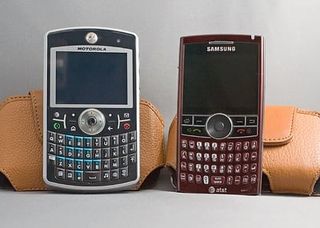
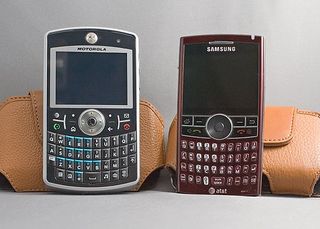
WMExperts has reviewed the Motorola Q9h, we've taken a close look at the BlackJack II, we've even already had one smackdown between the two devices. Still, the Q9h and the BJII are the top two WM Standard devices on AT&T and plenty of folks may still be considering one or the other. In my case, I've moved from a BlackJack II to a Motorola Q9h after a bit of thought and a bit of pressure from Dieter.
So I'm in the process of moving from the Blackjack II to the Motorola Q and One thing is for certain, I can't stand having to reload all the third party software and finding all the unlock codes that are scattered about my email. Note to self: organize these codes better. While I've got my hands on both devices, I thought I would offer my observations of these two Windows Mobile devices.
To hear more about these two devices, read on!
I moved from Palm OS to WM Pro and eventually found that WM Standard fit my needs better. In doing a bit of research, I choose the Samsung Blackjack II. The Blackjack II intrigued me with its thin form factor and coming from the Treo, I quickly discovered, thin was in.
While the Blackjack II was a really good introductory device to WM Standard, the smaller key board, slower processor and sometimes weak signal (granted the service provider was at fault at times) made me start to look elsewhere. Enter the Motorola Q9h.
The Motorola Q9h Global had a larger keypad, a faster processor and I kept hearing that the signal reception was noticeably better. It had one feature that also was attractive; voice dialing. But how did the Q9h measure up to the BJII? What was I going to miss about the BJII that the Q9h fell shy of?
Samsungs Blackjack II
The Blackjacks design is nice but I feel the Q9h's design is slightly better. The BJII has a full QWERTY keypad but the keys are noticeably smaller than the keypad on the Q9h. I found it easier to type on the Q9h than on the BJII because of the slightly larger keypad.
Get the Windows Central Newsletter
All the latest news, reviews, and guides for Windows and Xbox diehards.
Form Factor: Thin vs. Thin
The Samsung Blackjack II gets the nod with regards to size. The Blackjack II comes in at 4.4 x 2.3 x .04 inches while the Motorola Q9h measures 4.65 x 2.63 x .047 inches. The Blackjack is also lighter coming in at 3.52 ounces compared to the Q9h's 4.73 ounces. Regardless, both devices carry well in a shirt pocket or belt case and some of the size difference may be an illusion.

On paper these two devices are separated by fractions but for some reason, the Motorola Q looks considerably wider. Only .33 inches wider, the appearance of being two feet wider probably comes in the larger keypad and the contrast the black face/silver border the phone has. I've seen some of the all-black Q9s and they don't look as wide as AT&Ts Q9h. While the advantage in form factor might go to the Samsung, the Motorola isnt a slouch.
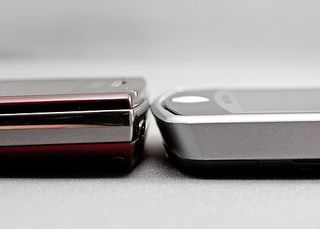
The Motorola Q9h does feel more solid than the Blackjack II. I can squeeze the sides of the Blackjack II and the casing will have a little play and will creak. I don't get either with the Q9h.
One comment that inevitably comes from black BJII owners is that the casing is really prone to smudges and finger prints. The red BJII has a textured back side and is less prone to the smudges/prints. The Motorola Q9h's back plate is a black, rubbery material that doesnt attract these smudges and offers a decent gripping surface. Where the Q9h attracts fingerprints is on the screen. The protective lens that sits on top of the screen attracts fingerprints the way the back of the black BJII does.
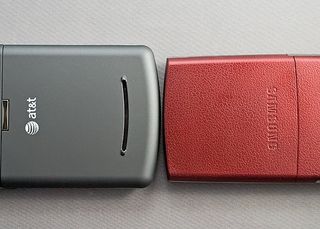
Layout and Design
While very similar in design, the most noticeable difference is the larger keypad of the Motorola Q9h. It takes up virtually all of the devices 2.63 inches of width. The keys are larger than the Blackjack IIs making it a little easier to navigate and type from. Both devices have hot keys on the key pad to launch applications and both have control buttons surrounding a four-way button, centered beneath the screen.
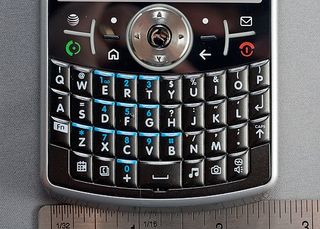

I can't say that one is necessarily better than the other but I don't particularly care for the placement of the ATT button on the Q9h and the lack of a hot key to activate the Task Manager. On the BJII, the ATT button is towards the bottom of the keypad (out of sight) and if you press and hold the home key, you activate the Task Manager. The Q9h puts the ATT button prominently at the top of the keypad. Pressing and holding the Home Key pulls up the Quick List and if you want a short cut to the Task Manager, you have to create a speed dial key.
Both devices have side control keys. The Blackjacks side toggle button controls volume while the Motorolas side buttons control volume and act as a forward, backward, and select buttons to navigate through Windows Mobile. The BJII does have the center wheel to scroll through the screen but that feature was always hit or miss for me.
The Blackjack II has a proprietary sync/charge/headphone jack while the Motorola Q has a micro-USB sync/charge/headphone port. Motorola was kind enough to package the Q with a micro-USB to 3.5mm headphone adapter and a micro-USB to mini-USB adapter. While I don't mind the BJIIs proprietary jack, the Q9hs seems more universal. However, after using the micro-USB slot for a few days, it would have been nice if Motorola had used a mini-USB port to eliminate the need for the adapter.
The displays of these two devices are just about equal in appearance and size. While its a coin toss as to which screen is better, if I had to give the edge to one or the other, it would have to be the Motorola Q. The Motorolas screen seems to be a touch larger and brighter. I can also see the Motorolas screen a little better outdoors.
Under the hood, the Motorola Q9h sports 325 mhz processor with 256mb of flash ROM and 96mb of RAM. The Blackjack II sports a 250mhz processor with 256mb of ROM and 128mb of RAM. While the processor speeds of the Blackjack II are good, the Motorola Q9h noticeably cruised from application to application quicker. Both devices have micro SD card slots to allow for expandable storage.
Applications
Heres my view on pre-loaded applications. If it has something nice and useful preloaded, thats a bonus. If somethings missing that I need, I load it. Granted if a WM device didnt have Outlook, Pocket Explorer or a Call Log, I'd be concerned. However if something like Gentimer, Live Search or Bubble Breaker is missing, I'm not going to loose sleep over it. Both the Blackjack II and Motorola Q9h are loaded with useful applications and both have built in GPS as well as onboard, two megapixel cameras.


There are some differences such as the BJII using Mobile Office while the Moto Q9h has Documents to Go. The Motorola has both Explorer and Opera loaded but defaults to Opera. The Samsung only has Explorer loaded. There are even some minor differences in the same application found on both devices. The Task Manager on the Blackjack gives you the option to Stop the application while the Motorola kills the application. The Motorola Q9h's Bluetooth manager breaks down the Bluetooth devices by function (hands free device, keyboard, etc.) while the Samsung does not.


There is one application on the Q9h that gives it an edge. The Motorola has a voice command application that not only allows you to voice dial but also to activate applications by voice. A lifetime ago, I carried a Motorola RAZR that had voice dialing and quickly found voice dialing to be a critical feature for phones.
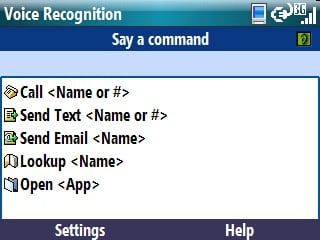
Its a coin toss as to which device is better and if one has something the other lacks, most can be uploaded. If one had the ability to delete the AT&T suite, it would be a clear winner. All in all, both phones are well loaded with applications.
Battery Life
Cutting to the chase, neither the BJII nor the Moto Q9h has an impressive battery. Motorola attempts to make up for this shortcoming by adding an extended battery but to use it, you have to increase the thickness of the device. Thats a trade off I don't really want to make so hopefully, one day, someone will come up with a standard sized, high cap battery.
In a very un-scientific test, I started the day with the Samsung battery fully charged. I used it in a normal manner; making calls, checking email, surfing the net a little and playing some games. The fully charged battery lasted 20 hours on the Blackjack II before receiving the Low Battery alert. Lighter usage yielded me 32 hours before receiving the warning. In contrast, the Motorola Q9hs battery lasted 16 hours under moderate use. The extended battery offers 2-3x the battery life but, again, doubles the thickness. While both these devices could use a standard sized, high capacity batter, I usually keep my device docked while in the office so the trickle charge helps get them through the busier days.
One more observation on the Q9hs battery is that at times it can get warm. Not uncomfortably warm but noticeably warm. This isn't uncommon with the newer smartphones that are running applications that are not as efficiently written as they perhaps ought to be.
Call Quality
Call quality on both phones was very good. The Moto Q9h has noticeably better speaker phone quality (probably due to the dual speakers) while the BJII's speaker is a little muted.
The biggest difference in phone performance with these two devices is signal strength.
Signal strength is a difficult thing to gauge because its not only affected by the device but also the service provider. If youre in a dead zone because of the lack of cell towers, no matter how great of a phone you have, youll still be in a dead zone.
The BJIIs signal reception wasnt really consistent. One second I'd have a 4 bar, 3G signal and two blocks over, it would drop to one bar on the Edge. The Motorola was more consistent and where I would have three bars on the BJII, the Q9h indicated four bars.
Final thoughts
After years of using PDAs, cell phones, and smartphones I have come to the conclusion that there is no one size fits all choice with these devices. Both the Samsung Blackjack II and Motorola Q9h are very good devices. I don't think either is a bad choice but one may be better based on your needs and tastes.
I think each device is designed for a specific audience. The BJII is more of a general purpose device offering a lot of features and abilities that will meet the needs of most users. The BJII has a slightly smaller form factor than the Q9h and that might be appealing as well.
The Moto Q9h would be more of an email/messaging device with the larger keypad, faster processor and stronger reception. The Moto Q9h has a slightly larger form factor but not enough to make it a brick.
Both phones have good call quality, a good selection of pre-loaded applications, a quality display, and onboard cameras and GPS. Both phones have batteries that could improve and lack WiFi.
I would like to see someone come out with a device that combines the form factor of the BJII and the features of the Motorola Q (toss in Wifi for an added bonus). Theres no telling what new devices are around the corner and who knows we might see something like this in the future.
For now, the BJII is an outstanding WM Standard device for the average user to the moderate user. If you use your device with more regularity for email, internet access, messaging, etc. or find yourself running more than one application at a time, the Q9h is better tuned for those needs.
Probably the best advice I can offer is to go to your neighborhood service provider store front and handle both devices. If you have hesitation over the larger Q9h, its taken my hand all of two days to get used to the slightly larger form factor and it now feels comfortable where the BJII feels almost too small.
To find out more from the manufacturers of these Windows Mobile Devices, check out these links.
Samsung Blackjack II

